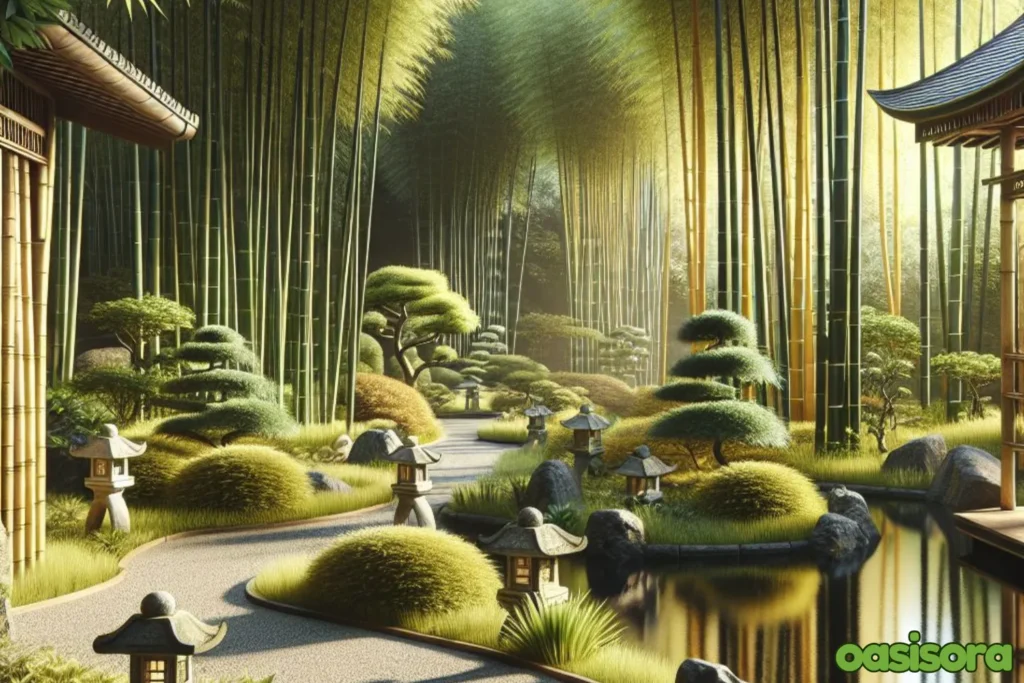
Do you want a peaceful and appealing bamboo in your yard?. Then, you are indeed at an ideal place!. Today, we will discuss garden bamboo, a key part of Japanese gardens. Bamboo adds stylishness and serenity to yards.
The whisper of this remarkable bamboo plant creates a soothing atmosphere ideal for meditation and relaxation. In Japanese culture, bamboo symbolizes strength and flexibility, making it a key component in traditional Zen gardening.
Plus, Japanese garden bamboo looks attractive and symbolic. It’s a great addition to any garden. The good part is that it is relatively easy to care for, and if you care for it properly, it can thrive in many diverse environments.
This blog is for those seeking a peaceful oasis or bamboo enthusiasts. We’ll explore Japanese bamboo gardens and share tips on incorporating it into your garden. So, stay tuned!.
Varieties and Types of Bamboo for Japanese Gardens
Hey…folks….New to Japanese gardening?. Start with the basics! Learn about the different types of bamboo and how to choose the ideal one for your garden:
1. Bambusa multiplex (Hedge Bamboo)
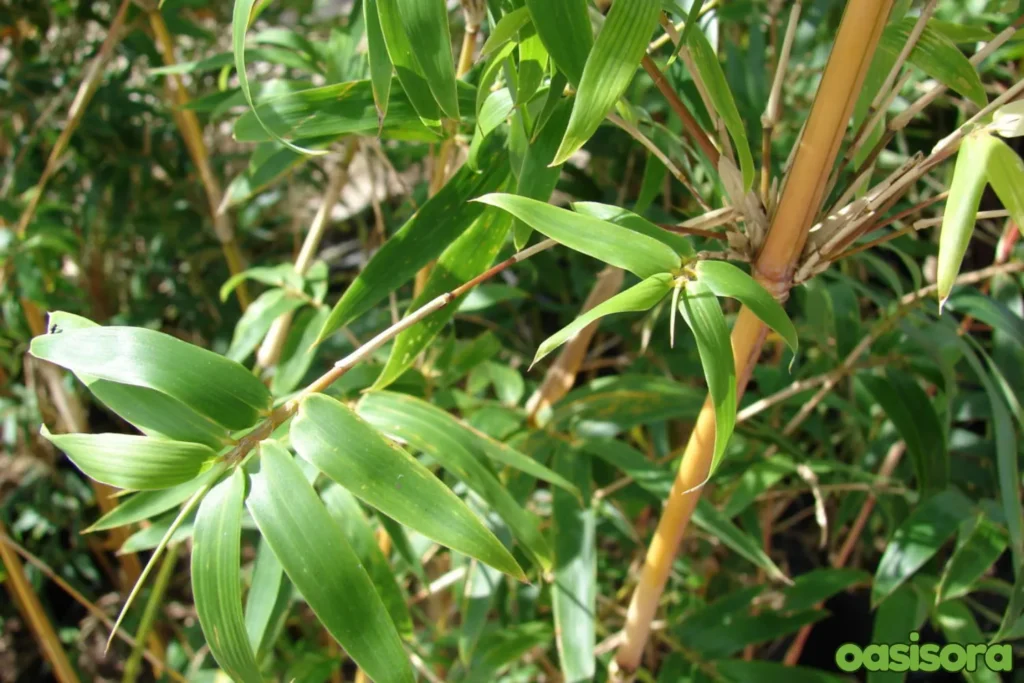
Bambusa multiplex (Hedge Bamboo)
As the name suggests, Hedge Bamboo is flawless for privacy. It grows close together and makes a dense screen. This bamboo has many leaves, making it a great green wall for your yard. It thrives in summer with little water.
This resilient Japanese garden bamboo can handle the heat but also needs some defense from the harshest midday sun. Partial shade is perfect for this bamboo.
Growth Patterns and Landscaping Ideas
Hedge Bamboo grows straight (up to 3 to 5 meters) and close together. It’s excellent for making a green wall or fence, hiding ugly views, or creating a private space.
Zone Requirements and Climate Considerations
This bamboo type likes warm weather and lots of water. It grows best in zones eight and above. Ensure it gets plenty of sunlight and water, especially in the hot summer.
Tips for Maintaining Healthy Hedge Bamboo
Read these tips to maintain a good-looking bamboo:
- Water often: Keep the soil moist, especially in hot summer months.
- Fertilize: Give your Hedge Bamboo fertilizer once a year to help it grow strong.
- Cut off dead stalks: Remove dead or damaged stalks to keep your bamboo healthy.
- Give it room: Give your hedge bamboo enough room to spread out and thrive.
- Get lots of sunlight: Plant hedge bamboo in an area that receives plenty of the sun light because it likes it.
2. Phyllostachys nigra (Black Bamboo)
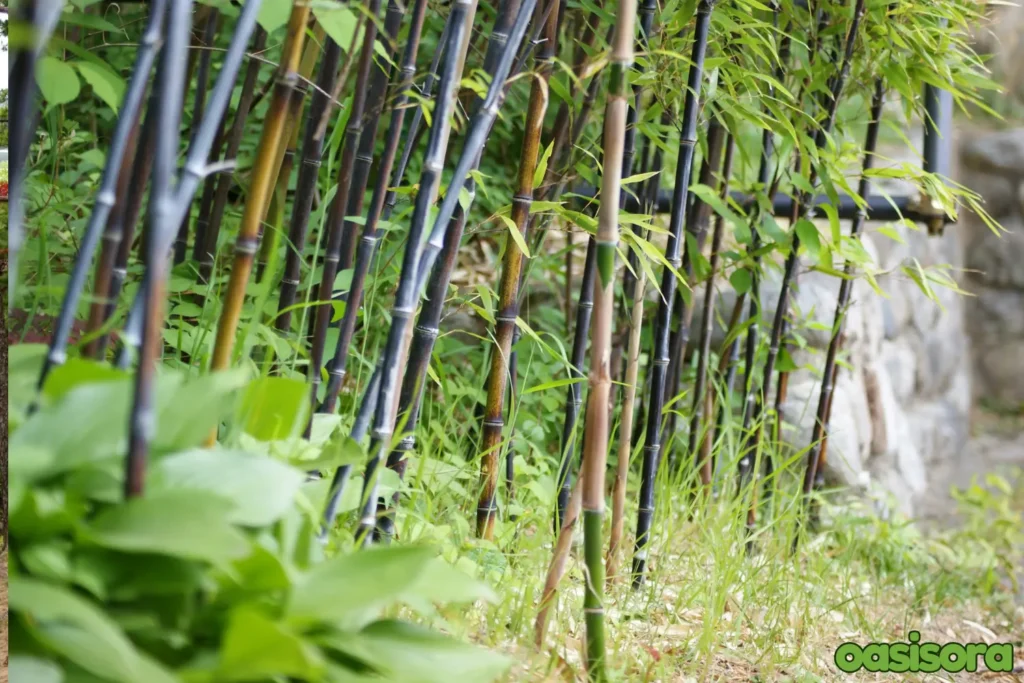
Phyllostachys nigra (Black Bamboo)
Want a unique Japanese garden bamboo?. Black bamboo is a great choice. It is an excellent pick for Zen gardens!. It starts green, then turns a deep, rich color.
It’s perfect for adding height and grandeur to more extensive gardens. Kuro-Chiku pairs very well with cheerful green plants or variegated foliage.
Strategic Placement to Maximize Space
Plant bamboo in the right spot and give it good space to grow. Think about how big it will get.
Essential Care Tips for Giant Bamboo
Here’s how to care for giant bamboo:
- Watering
Water giant bamboo a lot to keep the soil moist.
- Sunlight
Giant bamboo loves the sun! So, give it 6 hours of sun a day.
- Fertilization
Feed giant bamboo once a year. You can use a balanced fertilizer.
- Pruning
Cut off dead bamboo stalks using clean tools.
- Pest Control
You have to watch out for pests. Use natural pest control.
- Soil Care
Giant bamboo likes good soil. Add compost.
- Support
This Japanese garden bamboo can fall. Hence, use stakes or a trellis for support.
Using Giant Bamboo in Zen Gardens
This Bamboo is excellent! It looks nice, gives shade, and hides things. You can plant it in a pot or use it as a privacy wall. Take care of it and it will make you happy!
3. Phyllostachys bambusoides (Giant Bamboo)
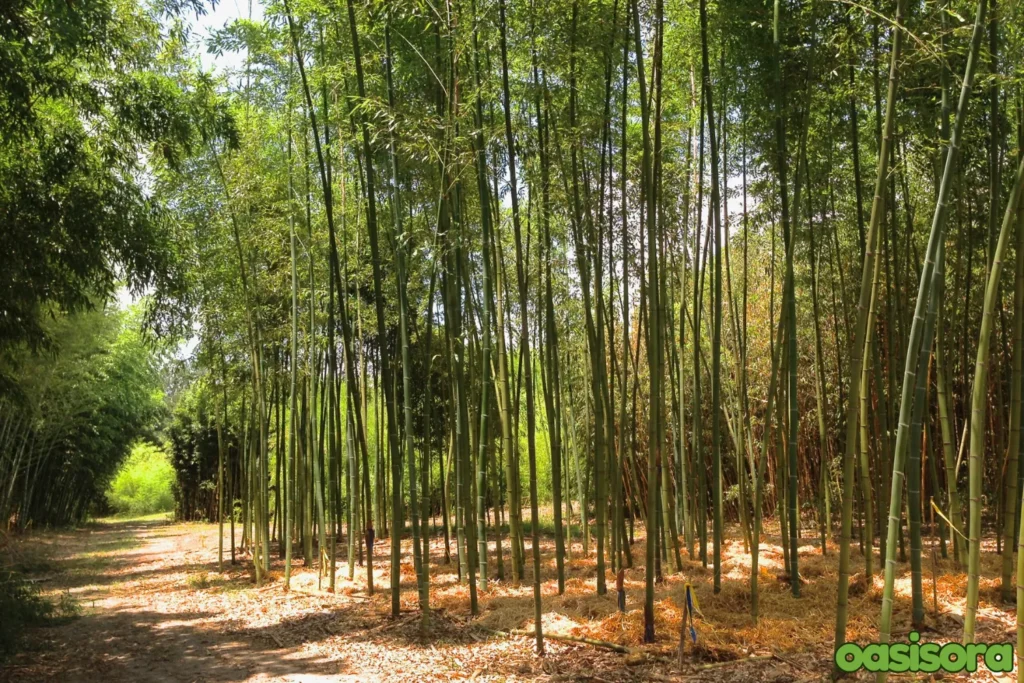
Phyllostachys bambusoides (Giant Bamboo)
Ma-Dake bamboo grows strong and straight. It’s excellent for building and crafting, but it also looks fantastic in gardens!. Its striking black stalks contrast with your garden and make it look super cool.
Creating a Visual Impact with Black Bamboo
Black Bamboo adds enormous visual appeal to your yard!. It’s super pretty and adds contrast to gardens. It’s also great for building things like fences and trellises.
Due to its strong and tall traits, it is a valuable and beautiful addition to your garden. Ma-Dake can grow tall—up to 10 to 20 meters! So, it’s best for big gardens with lots of growing space.
Best Practices for Care and Growth Control
Follow these tips for caring for this bamboo:
- Don’t Forget to Water it
Water your Black Bamboo often. Check it by stabbing your finger in it. If it feels dry, give it a big drink!
- Give it Some Sun
Black Bamboo loves sunshine! Pick a spot that gets lots of direct sunlight every day – at least 4-6 hours is perfect!
- Feed it Once a Year
Give your Black Bamboo a snack once a year with a balanced fertilizer. This will keep it strong and healthy.
- Prune with Care
Remove dead or broken stalks to keep your Black Bamboo healthy and pretty. Use clean, sharp tools to cut them off, so you don’t spread any sickness.
- Protect it from Harsh Winds
Protect your Black Bamboo from strong winds that can hurt or break it. If you live in a windy spot, find a cozy place for it to stay safe!
Suitable Garden Designs Featuring Black Bamboo
Now read about the various Japanese garden bamboo designs:
- Create a Natural Border
Use Black Bamboo to make a pretty border or fence in your garden.
- Add a Reflective Touch
Plant Black Bamboo near water and it will look amazing reflected!
- Mix and Match
Plant Black Bamboo with flowers or shrubs to make a colorful garden.
- Make a Statement
Use Black Bamboo as the main feature in a small garden or courtyard for a significant impact!
Create a Peaceful Oasis
Plant multiple Black Bamboo plants together to create a serene and peaceful bamboo forest in your garden.
4. Sasa veitchii (Dwarf Bamboo)
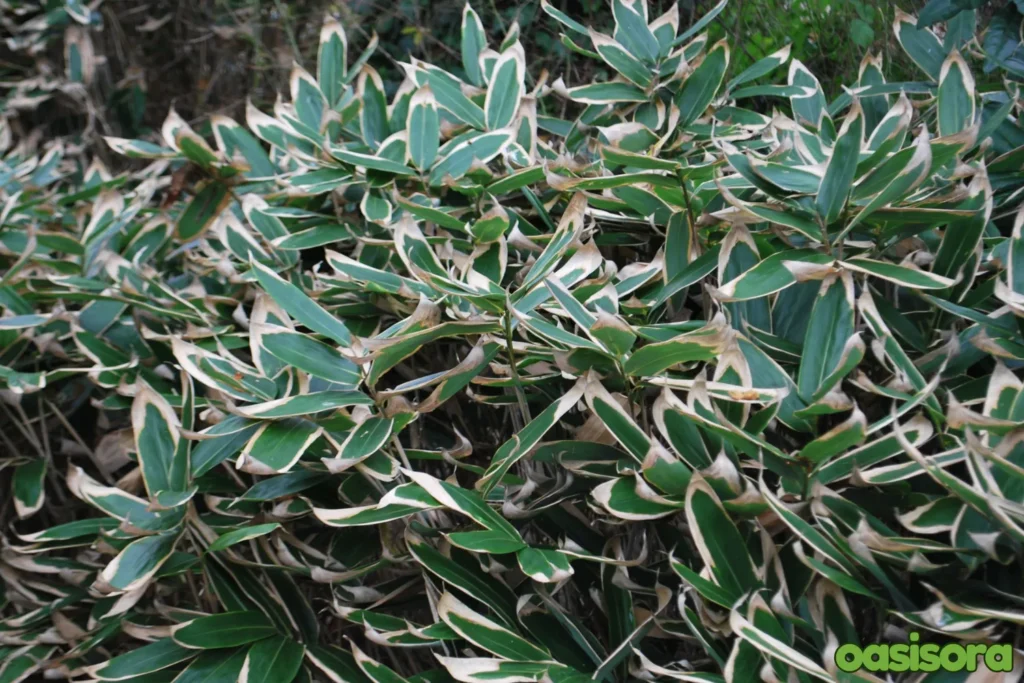
Sasa veitchi (Dwarf Bamboo)
Want to add a hint of natural appeal to your yard?. Then, pick awesome Japanese garden bamboo-Dwarf Bamboo! Dwarf….isn’t the name interesting?.
This small but mighty bamboo plant is ideal for your yard’s borders and accents. Plus, it adds texture to your outdoor space. With its minimal growth and low-maintenance traits, Dwarf Bamboo is a must-have choice for gardeners of all levels, new or old.
How Dwarf Bamboo Adds Texture?
Dwarf bamboo’s peculiar stems and leaves give gardens texture, and its layered, naturalistic appearance is wonderful for giving your outdoor area depth.
Choosing the Right Varieties
Pick a Dwarf Bamboo variety that fits your local climate. Some types thrive in cold weather, while others love the heat. Choose the right one, and your Dwarf Bamboo will flourish!
Maintaining Compact Growth
Water your Dwarf Bamboo regularly and give it plenty of sunlight to keep it looking like new. Prune it back to keep its compact shape, and enjoy its beauty all year round!
5. Semiarundinaria fastuosa (Narihira Bamboo)
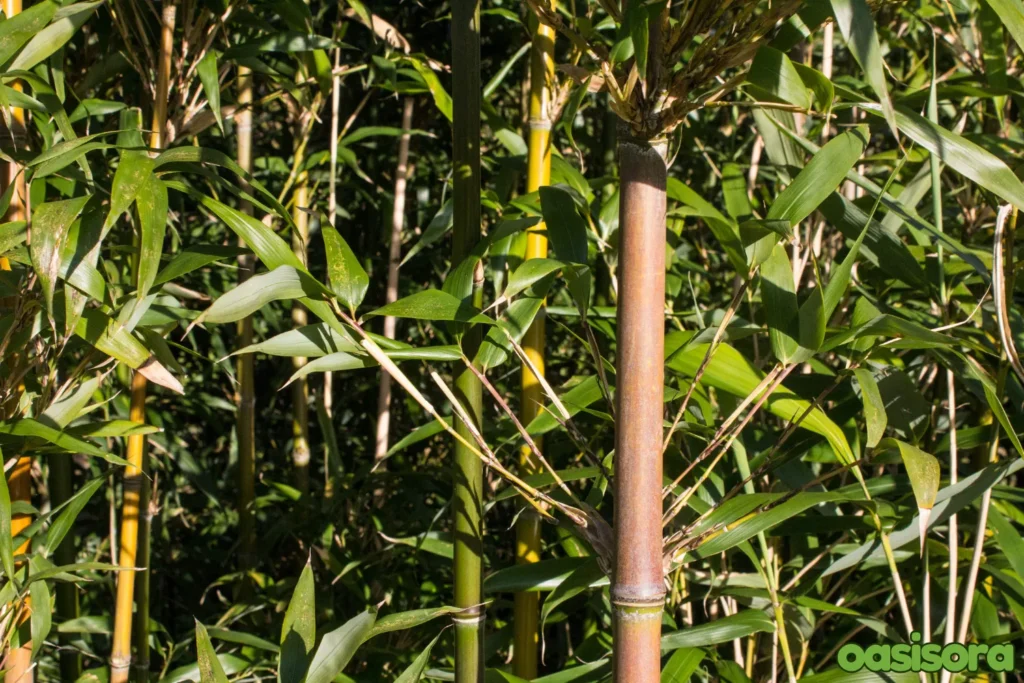
Semiarundinaria fastuosa (Narihira Bamboo)
A lovely, graceful, and upright bamboo plant, Narihira Bamboo is also an attractive way to add symmetry to your Zen garden. Its deep green coloring makes a beautiful background for blooming plants.
Growing Narihira Bamboo for Vertical Accents
Narihira Bamboo grows up straight and tall, up to 5 meters high. It adds a vertical touch to your garden. It spreads out, so give it space or keep it contained.
Changing to Fit Different Climates and Garden Styles
This bamboo thrives in a variety of environments, grows well in zones 6–9, and can withstand freezing temperatures. It is comparatively stronger than other bamboo types.
Year-Round Color Shifts: How to Maximize Seasonal Beauty
This type of Bamboo leaves change color with the seasons. They turn a nice bronze color in fall, making your garden feel cozy and autumn-like.
6. Pleioblastus simonii (Me-Dake Bamboo)
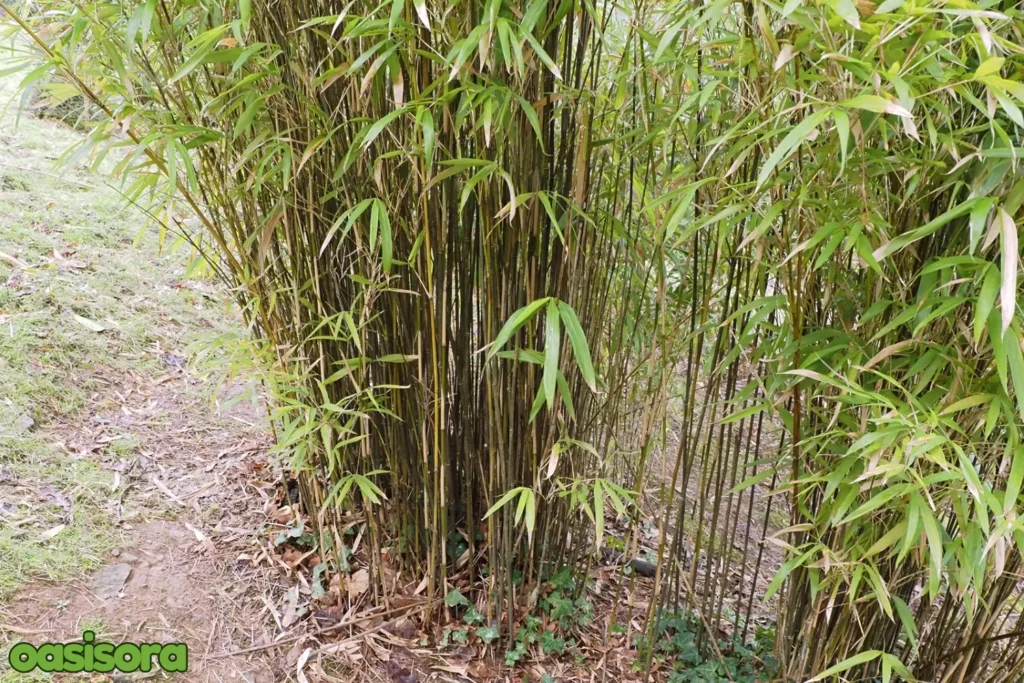
Pleioblastus simonii (Me-Dake Bamboo)
Me-Dake bamboo is a small and flawless bamboo plant. It’s functional for small gardens because it doesn’t take up much space and offers hedging or screening purposes.
Ideal Locations and Soil Conditions for Me-Dake
Me-Dake bamboo thrives in partially or completely shaded areas and prefers moist soil with adequate drainage.
How to Create Defined Spaces Using Me-Dake
This Japanese garden bamboo is excellent for making your garden look neat and organized. It grows thickly and can mark the edges of different areas. It’s also a nice green base for taller plants, helping create a beautiful and defined space in your garden.
Health and Care Tips for Long-Term Growth
Here are five easy health and care tips for Me-Dake bamboo:
- Water Regularly
Don’t let the soil get too damp.
- Provide Good Drainage
You have to make sure the soil drains well to prevent root rot.
- Give Partial Shade
Me-Dake bamboo prefers shady or partly sunny spots so place them accordingly.
- Fertilize Lightly
Feed these bamboo with a balanced fertilizer during the growing season.
- Prune Regularly
Cut back dead or damaged stems to keep your bamboo healthy.
7. Phyllostachys aureosulcata (Yellow Groove Bamboo)
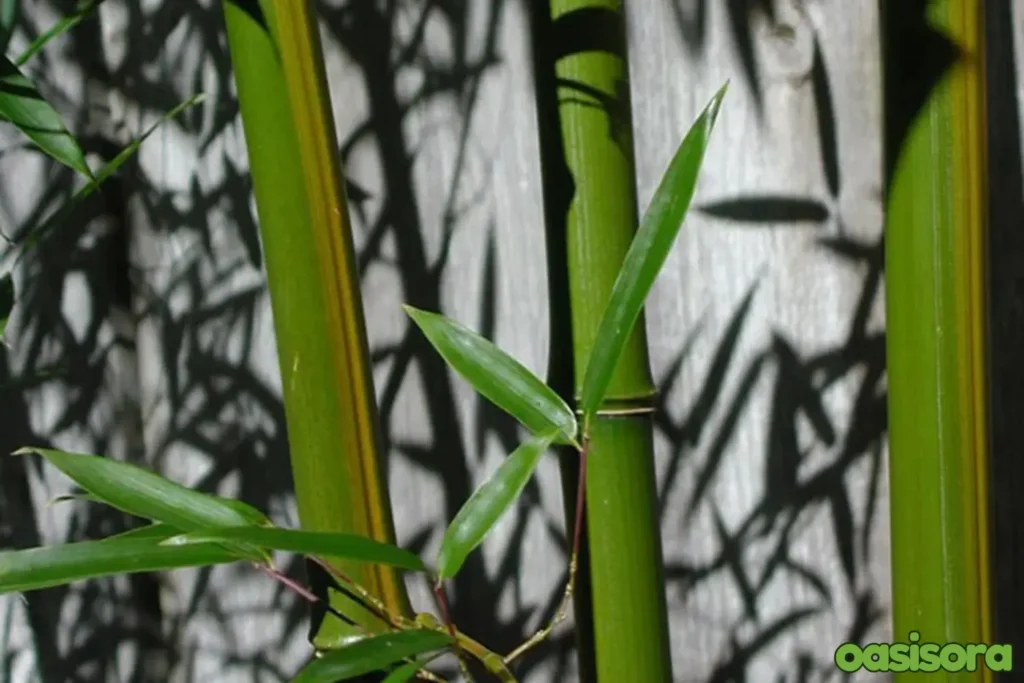
Phyllostachys aureosulcata
Do you love the yellow color?. Then, indeed Yellow Groove Bamboo is fantastic for you. It has bright yellow-green stems. It adds light to dark garden areas and makes them look beautiful.
Integrating Yellow Groove Bamboo into Garden Designs
Yellow Japanese garden bamboo makes gardens beautiful. It adds richness, mystery, color, and texture, making your yard unique.
Best Placement for Sunlight and Shade
This kind of Bamboo likes partial shade. It’s happy with morning sun and afternoon shade. This helps it grow strong and healthy.
Low-maintenance Care for Optimal Growth
You can easily care for this bamboo by following these tips:
- Soil Needs
Fertile soil that is damp yet well-drained is ideal for its growth.
- Sun Requirements
Give it a full or partial shade to prosper.
- Fertilizing
When the soil seems dry, water it; sometimes fertilize it to help grow.
- Pruning
To maintain its health and best appearance, trim any dead stems.
8. Fargesia robusta (Umbrella Bamboo)
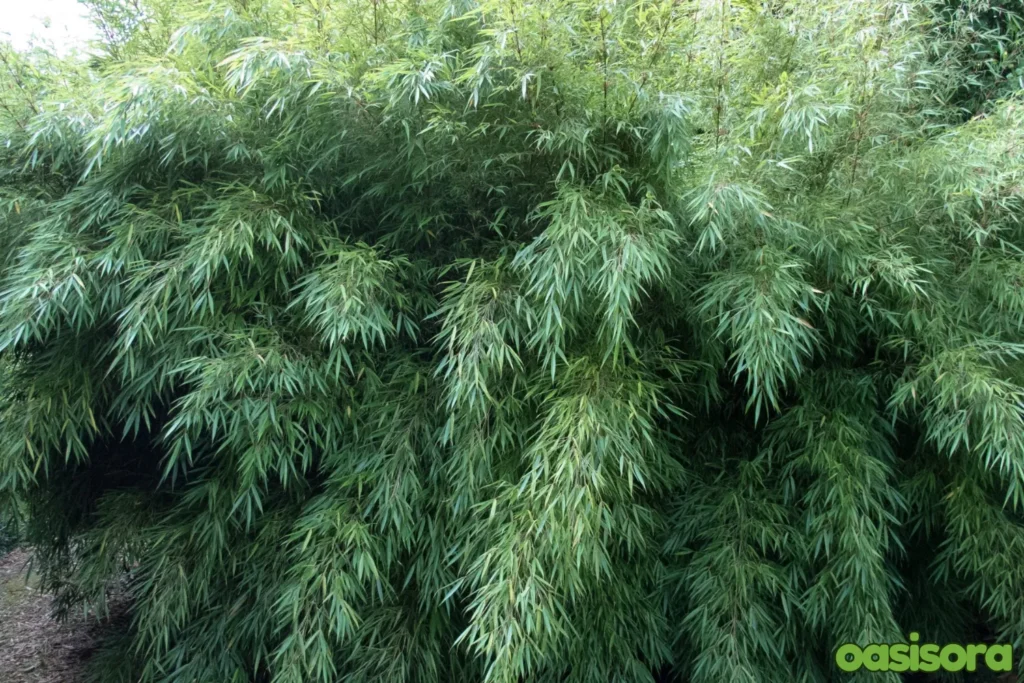
Fargesia robusta (Umbrella Bamboo)
Umbrella Bamboo is one of the long-cultivated series of Japanese garden bamboo that is ideal for small gardens. It’s tall and slender, doesn’t spread too much, and handles cold weather. It’s also regarded as one of the best bamboos that can be ideally used for a screen or yard hedges.
Best Bamboo for Contained Growth
Umbrella Bamboo is perfect for small spaces. It grows well in containers and doesn’t take over.
Winter Care Tips for Cold Climates
Follow these fantastic tips to keep umbrella bamboo healthy:
- Protect from Strong Winds
Keep your Umbrella Bamboo away from strong winds that can damage its stems.
- Shield from Extreme Cold
Cover or bring plants under a shelter to protect them from extreme cold snaps.
- Mulch around the Base
To keep the soil cozy and toasty, spread mulch around the base.
- Keep Soil Moist
Water Umbrella Bamboo regularly, even in winter, to keep the soil moist.
- Don’t Do Over-Pruning
Don’t cut too much of the bamboo in winter. This can hurt the plant. Wait until spring to prune.
Adding Non-Invasive Bamboo Varieties to Zen Gardens
Umbrella bamboo is excellent for extraordinary Zen gardens. Umbrella bamboo stays in its place. It doesn’t spread too much. It makes your outdoor space feel peaceful and calm. It looks natural and beautiful.
Why Bamboo in Japanese Gardens?
Bamboo is vital in Japanese gardens, symbolizing strength, flexibility, and longevity. Its unique texture, movement, and sound create a peaceful atmosphere. This makes it supreme for traditional Zen gardens.
Also, it promotes tranquility, simplicity, and connection with nature, reflecting the principles of Japanese landscaping.
Key Benefits of Bamboo in Japanese Gardens
Here are the main perks that Japanese Garden Bamboo offers:
Screen and Hedges of Yard
Japanese bamboo is excellent for gardens. It makes good screens and hedges. It grows densely and looks nice. The different kinds of bamboo offer different looks to your yard. Some are tall and skinny.
Others are short and bushy. However, you can choose the best type for your garden. The use of bamboo can make your garden super private and quiet. Plus, it’s easy to grow and looks appealing.
Serene Atmosphere
The leaves of bamboo sprinkle a soft rustle, one of its most alluring features. This soothing sound produces a calm feel that enhances the coziness and tranquility of your outdoor oasis.
Adaptability to Different Climates and Conditions
Bamboo is a versatile plant that can handle various climates and conditions. It can grow in hot or cold weather, making it a multipurpose plant.
Common Myths About Bamboo
Now folks, let’s read common myths of Japanese Garden Bamboo:
Is Bamboo Invasive?
Yes, numerous sorts of bamboo can be highly invasive. It can spread quickly by underground stems called rhizomes.
Invasive Bamboo Kinds
Here are two invasive types of bamboo:
- Running bamboo:
Spreads through long rhizomes (up to 6m). Causes problems in small gardens or near fences.
- Some non-clumping bamboos:
Found in temperate regions, these bamboo can be invasive. Hjk
How can bamboo be invasive?
- Bamboo breaks through tarmac and grows under patios.
- It crosses boundaries and causes neighbor conflicts.
- Bamboo roots spread into homes through cracks.
Difference of Clumping and Running Bamboo
Here’s the main difference:
Clumping Bamboo:
- Grows in tight clusters
- New shoots emerge from the center of the plant
- Non-invasive, well-behaved, and easy to manage
Running Bamboo:
- Spreads quickly through underground rhizomes
- New shoots grow from the center
- Non-invasive and well-behaved
- Easy to manage
Managing Growth of Bamboo:
Here’s how you can manage it:
- Choose clumping bamboo for small spaces.
- Contains running bamboo with a barrier.
- Prune running bamboo regularly.
- Remove stray shoots.
- Get professional help if needed.
Can Foundations Get Damaged by Bamboo?
Bamboo can, in fact, damage foundations, especially weak or damaged ones. Its fast growth and underground spread put pressure on foundations.
To avoid foundation damage:
- Choose clumping bamboo.
- Plant 3-5 feet away from structures.
- Use a rhizome barrier.
- Prune regularly.
- Monitor for damage.
How to Select the Best Bamboo for Your Japanese Garden
When choosing Japanese garden bamboo for your yard, consider:
- Growth habit: Clumping (preferred) or running (needs management)
- Climate and hardiness: Temperature tolerance, summer heat
- Size and appearance: Mature height, cane color, leaf size
- Sunlight requirements: Full sun or shade tolerance
Prioritize non-invasive, clump-forming varieties that suit your climate, space, and maintenance level.
Design Tips for Using Bamboo in Your Garden
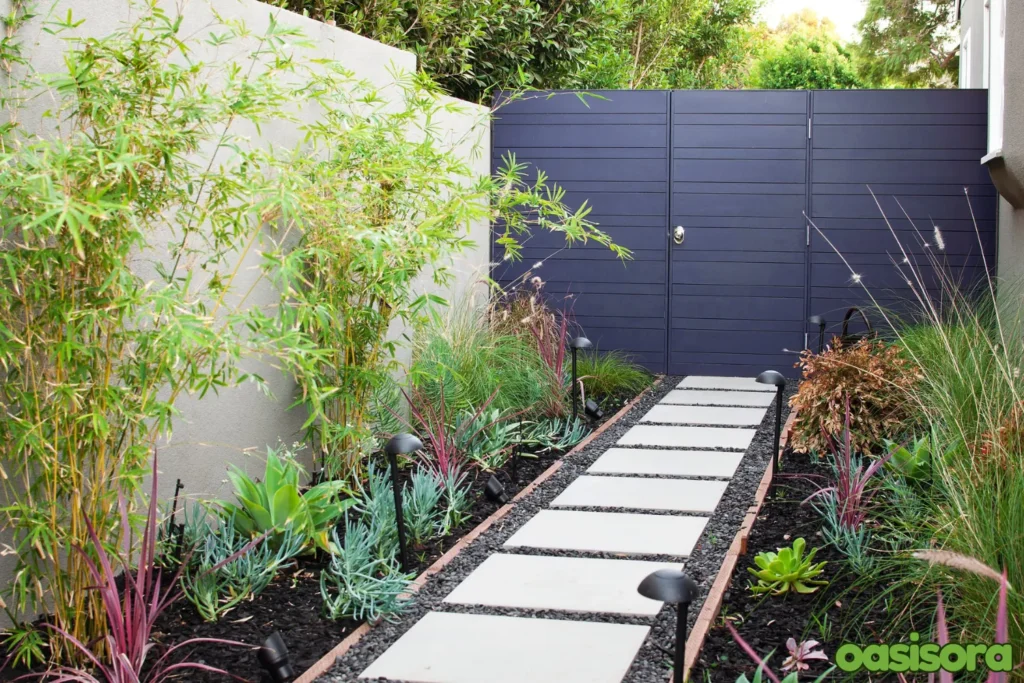
Bamboo Design idea for Garden
The following design advice can help you incorporate bamboo into your garden:
- Bamboo as a Hedge or Privacy Screen
Plant bamboo closely together to create a dense screen. Choose tall, clumping varieties for the best results. Pruning it often will maintain shape and stimulate healthy growth.
- Bamboo Around Water Features
Plant bamboo next to fountains or ponds to create a peaceful environment. For a calmer look, pick cultivars with delicate foliage. Consider adding lighting to highlight the bamboo and water features.
- Bamboo as a Standalone Feature
Use bamboo as a focal point in minimalist garden designs. Choose a striking or unusual variety to create visual interest. Plant in a decorative container or surround with gravel for added effect
Seasonal Bamboo Care Guide
Here’s a seasonal bamboo care guide:
Spring (March to May)
- Prune dead or damaged canes
- Remove any weak or spindly growth
- Water regularly as new shoots emerge
Summer (June to August)
- Keep watering frequently, but don’t overwater
- Mulch the base to keep moisture in and keep weeds out
Autumn (September to November)
- Reduce watering as the weather cools
- Prune any dead or dying leaves
- Consider protecting young plants from frost
Winter (December to February)
- Reduce watering to once a month
- Protect plants from extreme cold and wind
- Plan for spring pruning and maintenance
Maximizing Bamboo’s Longevity: Maintenance and Sustainability Tips
Read these key tips for the long life of your Japanese garden bamboo:
Sustainable Practices
Here are some sustainable tips for a longer lifespan of your bamboo:
- Water wisely: Stay aware of overwatering as this might cause root rot.
- Mulch and compost: Retain moisture and suppress weeds with organic mulch.
- Prune regularly: Remove dead or damaged canes to promote healthy growth.
Maintenance Tips
Here are some maintenance tips for a longer lifespan of your bamboo:
- Monitor for pests: Check frequently for indications of illnesses or pests.
- Provide support: Stake or cage tall plants to prevent damage from wind or snow.
- Divide and replant: Every 5-7 years, divide and replant to maintain plant vigor.
Bamboo in Zen Garden Landscaping: A Tranquil Touch
Bamboo in Zen gardens creates peaceful spaces. It is a natural beauty, and its soothing sounds add visual interest, movement, and calming noise to your garden. Bamboo symbolizes strength and resilience.
Final Thoughts:
Elevate Your Garden with Bamboo
Japanese garden bamboo adds calm to your yard. It’s easy to find a type that fits. With good care, it grows well and brings serenity. Bamboo makes gardens private and quiet. It’s easy to grow and looks nice.
Different bamboos offer distinct looks. Choose the best kind for your garden and enjoy its beauty and peacefulness. This promotes relaxation and serenity in your outdoor space.
Japanese garden bamboo is perfect for any yard, bringing beauty and calmness. Try the Japanese bamboo gardening today!.
So what are you waiting for?. Try the Japanese bamboo gardening today!.
FAQs
- Which bamboo species are excellent for tiny Japanese yards?
The tiny bamboo kinds are ideal for such yards.
- How can bamboo be prevented from spreading uncontrollably?
For spread control, you can utilize barriers and plants.
- Can we grow Japanese garden bamboo in cold weather?
Yes, some sorts of bamboo can grow well in colder weather.
- What soil kind is good for bamboo growth?
To grow it properly, give fertile soil and adequate drainage.
- How to prune your bamboo for the best growth?
To get rid of dead sections, prune bamboo in the spring.
